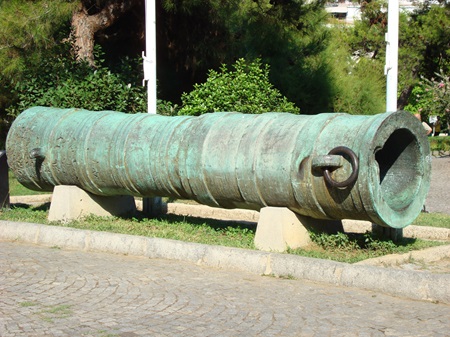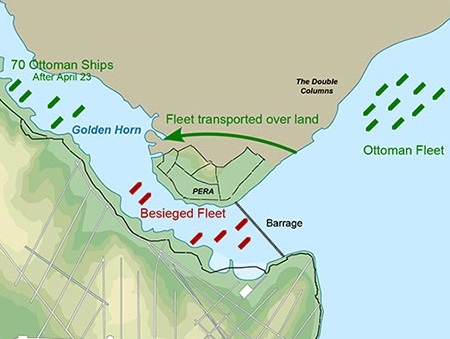The Byzantine city of Constantinople was a powerful representation of Christianity and for the Ottomans, a symbol of opposition to Islam. The “Red Apple” was an expression that represented the dream of almost every Ottoman to seize Constantinople, and it was a dream shared by Mehmed the Conqueror. Before Mehmed II, twelve other Muslim leaders had attempted to capture the city. Against the advice of his advisors, who feared reprisals from the Christians, Mehmed embarked on his pursuit to fulfill the dream and prophecy. Fifty-four days after ordering the assault, Mehmed entered Constantinople victorious, showcasing to his people that he had received the divine blessing. Mehmed succeeded in his conquest, where others had failed due to his innovative mindset and talent for finding solutions. These capabilities are well illustrated in three aspects of the 1453 siege. First, the planning and construction of the Bosporus Fort. Second, the design and use of a new super cannon. Lastly, the moving of ships overland to bypass the boom protecting the Golden Horn.
The Bosphorus Fort
The preparation and construction of the Bosphorus fort on the European side of the strait typify Mehmed’s resourceful mindset and capacity to overcome obstacles. The first step in the preparation of the siege was being able to perform an effective blockade. To do that, Mehmed knew he needed to upgrade his navy and control both sides of the straight. The Ottomans already had a fort on the Asian side, but adding a fort on the European side would make any blockade attempt more successful. Plus, controlling the strait provided additional benefits. On a journey back home, Mehmed could not cross the Dardanelles due to Christian ships in the water. Mehmed, frustrated, eventually crossed at a different location, and realized he had to do something to enable easier passage. The fifteenth-century scholar Kritovoulos relays that Mehmed understood that using two forts to control both sides of the strait would link the continents and allow easy passage to and from Europe without having to negotiate passage with others.
A driven Mehmed went to work and ordered one hundred navy vessels built, twenty of which were mid-sized galleys. Kritovoulos asserts that Mehmed had the insight to know that his new fort and ships would alarm and infuriate the Byzantines, and he found the correct words to appease them with a mixture of promises, threats, and explanations. Mehmed was not one to over-delegate and leave his workers feeling abandoned. It must have been highly motivating to his army and engineers to see Mehmed participate in the planning and day-to-day operations. Mehmed marched with his army to the European side of the straights. Mehmed himself went out on horseback surveying the land and taking note of both the sea’s currents and the land’s topography. After personally selecting the site for the fort, Mehmed staked out the foundation and the locations for towers, turrets, gates, and more. Mehmed demonstrated exceptional wisdom and leadership by motivating his army through the creation of rivalries and by awarding accolades for quick, quality work. Mehmed’s propensity to overcome obstacles is perfectly illustrated by completing the fort in just five months.
Mehmed’s design exemplifies his inventive mindset. It had two corners on the shoreline, forming a triangular shape. In between those two corners were the fort’s thickest walls and strategically placed towers. This innovative design was easy to defend and allowed the Ottomans to control a large amount of shore and ample space to place their artillery machines, allowing them command of the strait. Four hundred men garrisoned the fort, defending it with cannons and artillery machines, including a shore-mounted cannon capable of firing 600-pound projectiles. The fort’s commander started demanding tolls from passing ships, threatening any non-compliant vessel with a watery grave.

The Super Cannon
Mehmed’s shrewdness and ability to tackle challenges are evident in the super cannon utilized during the siege. Armies had envisioned the significance of cannons in siege warfare for well over a century before Mehmed conquered Constantinople. However, the cannons during the century before the 1453 conquest were not powerful enough to destroy a solidly built wall. In fact, the Ottomans had used cannons in a failed siege of Constantinople in 1422. Since his youth, Mehmed had shown an allure to science and was aware of the value of artillery, and from the beginning days of his rule, he directed his casters to attempt to make larger, more powerful cannons. A Hungarian named Orban approached Mehmed, claiming he could cast a cannon so powerful that it could level the walls of Babylon. Mehmed, an excellent appraiser of ability, was not rigid in his thinking and was willing to use the talents of non-Muslims to tackle obstacles. Mehmed knew a good idea when he heard one, and upon hearing Orban’s concept for a great cannon, he took him under his protection and paid him a higher wage than Orban had sought. Orban produced his first great cannon, successfully testing it on a Venetian ship. Thereupon, Mehmed requested another cannon twice the size of the first one. Orban successfully tested the second cannon, which was so heavy that they had to reinforce the bridges on the road to Constantinople for its transportation.
During the siege, the monstrous cannon and other cannons created by Orban were highly successful. The super cannon, which fired 1,500-pound projectiles, was made even more effective by an innovative way Mehmed used his ordinary canons in conjunction. Mehmed’s army loosened the walls with three shots in the shape of a triangle followed by a final shot from the colossal cannon directly in the middle. The large cannon fire destroyed large portions of the wall. The Orban-designed cannons also partially disintegrated towers and turrets. Beyond the physical devastation brought on by the new cannons, the mental effects on the defenders of Constantinople were also devastating, as the noise, vibrations, and the shattering of structures sent civilians into a panic.

Moving Ships Over Land
A third event in the conquest of Constantinople that exhibits Mehmed’s talent for creative problem-solving was the moving of ships overland to bypass a huge chain that blocked the strategic Golden Horn harbor. Mehmed realized that to be successful, his navy needed to gain access to the Golden Horn Harbor. But how? The boon that stretched across the harbor seemed indestructible. Mehmed devised an outside-the-box idea that exhibits his capacity for creative thinking and problem-solving. Mehmed knew that the Venetians had once transported an entire fleet from one body of water to another using wheeled platforms. However, the Venetians had performed the feat on flat ground. To achieve something similar, Mehmed would have to do what appeared impossible: navigate over a two-hundred-foot-tall hill. Mehmed’s engineers improved a rough pathway up the steep hill and constructed a sort of causeway using greased logs. At the same time, Mehmed directed the fitting of the ships with wooden cradles.
Kritovoulos reports that they flawlessly executed the plan, swiftly pulling the ships up the hill and down the other side. As the plan’s success became evident, hope filled the Ottomans, and some celebrated by boarding the ships, raising the sails, and rowing the oars as if they were on the water. Almost seventy ships successfully reached the Golden Horn. Upon learning what transpired, the Byzantines entered a complete state of panic. After the Ottoman navy entered the Golden Horn, a battle took place where the defenders faced defeat, resulting in the loss of approximately ninety of their finest sailors. Due to the sagacity of Mehmed, the harbor was no longer secure. The Ottomans could now threaten both land and harbor walls and still had enough navy power to enforce the blockade. Kritovoulos described Mehmed’s plan as “one worthy of his intellect,” and the nineteenth-century historian Felidio Canuti termed the scheme “worthy of the greatest military genius.”

Summary
Mehmet the Conqueror was the thirteenth Muslim leader who attempted to seize the Christian city of Constantinople. Mehmet’s wisdom, innovation, and drive helped him succeed where other leaders had failed. From the design and construction of the Bosporus fort to the design and usage of new cannons to the inventive idea of how to move ships over land, Mehmet showed a unique ability to think strategically, find creative solutions, and stay focused on the objective. The Prophet Muhammad declared, “one day Constantinople will definitely be conquered. What a good Amir and what a good army is the one that will accomplish this.” Mehmet used his talents to fulfillment of the Ottomans’ prophecies and dreams, and in doing so, cemented himself as a good Amir.

History is full of questions, and I enjoy trying to find answers to those questions. I hold two master’s degrees, one in History, and the other in Theological Studies. I enjoy ancient & classical history, the early church, European history, golf, basketball, dogs, and more. I spend my free time reading, writing, and watching historical documentaries. You can reach out to me at: wadleydd@gmail.com





